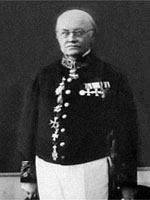Carl Ruland
Carl Ruland (also Karl Ruland) (born July 15, 1834 in Frankfurt am Main , † November 13, 1907 in Weimar ) was a German art and literary historian.
life and work
From 1851 Ruland studied philosophy and art history at the universities in Bonn and Tübingen . After receiving his doctorate, he was from 1859 librarian , private secretary and administrator of the art collection of Prince Consort Albert of Saxe-Coburg and Gotha at the court in London. He was considered a close confidante of the royal family and after Albert's death remained private secretary to Queen Victoria and educator of her children. In 1870 he became director of the grand ducal art collections and museums in Weimar . Ruland was a Privy Councilor and in 1886 became the first director of the newly founded Goethe National Museum and President of the Goethe Society , both in Weimar. From 1894 Ruland was a member of the Erfurt Academy . He worked as an author on the Allgemeine Deutsche Biographie .
In March 1873 he accompanied Princess Alice of Great Britain and Ireland , the second daughter of Queen Victoria and later Grand Duchess of Hesse and the Rhine, on her trip to Italy in 1873 to Florence and Rome. Alice writes to her mother on February 19, 1873: "The Grand Duke of Weimar has kindly allowed Mr. Ruland to accompany us as Cicerone, which is very necessary for collections of paintings, etc."
An anatomical drawing by Leonardo da Vinci (1452–1519), of which all other motifs are in the possession of the English royal family in the library of Windsor Castle , could have reached the Weimar collection of Italian masters via Ruland .
Fonts
- The Luther exhibition of the Grand Ducal Museum in Weimar , Grossherzogliches Museum, Weimar, 1883
- The treasures of the Goethe National Museum in Weimar , 1887
literature
- Franz Neubert (Hrsg.): Deutsches Zeitgenossenlexikon: biographical manual of German men and women of the present . Schulze, Leipzig 1905.
- Anton Bettelheim: Biographical Yearbook and German Nekrolog. Born 6.1901 - 18.1913. Reimer, Berlin 1904–1913.
- Walther Killy, Rudolf Vierhaus (ed.): German Biographical Encyclopedia. -: Saur, Munich [et al.] 1995-1999.
- Karl Sell (Ed.) Alice, Grand Duchess of Hesse and the Rhine, Princess of Great Britain and Ireland. Messages from her life and from her letters . . Published by A. Bergsträsser, Darmstadt. 4th edition 1884
Web links
- Literature by and about Carl Ruland in the catalog of the German National Library
- Works by and about Carl Ruland in the German Digital Library
- Search for Carl Ruland in the SPK digital portal of the Prussian Cultural Heritage Foundation
- Carl Ruland: Private Secretary of the Royal Family , Ulrike Müller-Harang, Blog of the Klassik Stiftung Weimar
- Carl Ruland: Call of the Crown Prince to Berlin , Ulrike Müller-Harang, Blog of the Klassik Stiftung Weimar
Individual evidence
- ^ Carl Ruland intimate I | Classic Foundation blog. In: blog.klassik-stiftung.de. Retrieved July 8, 2016 .
- ^ Walter Killy, Rudolf Vierhaus: German Biographical Encyclopedia . Munich, 1998, vol. 8, p. 461.
- ↑ AugenBlick: Messages from the Friends of the Goethe National Museum Weimar e. V. , 2005 (PDF, German; 405 kB)
- ↑ goethe-gesellschaft.de
- ↑ Original text of the letter
- ↑ Karl Sell (ed.): ALICE, Grand Duchess of Hesse and the Rhine, messages from her life and from her letters . 4th edition. Arnold Bergsträsser, Darmstadt 1884, p. 325 .
- ↑ Dirk Schultheiss: Anatomical-medical illustration: The Weimar sheet by Leonardo da Vinci . ( Page no longer available , search in web archives ) Info: The link was automatically marked as defective. Please check the link according to the instructions and then remove this notice. In: Deutsches Ärzteblatt , 1999; 96 (41): A-2608 / B-2226 / C-2090
| personal data | |
|---|---|
| SURNAME | Ruland, Carl |
| BRIEF DESCRIPTION | German art and literary historian |
| DATE OF BIRTH | July 15, 1834 |
| PLACE OF BIRTH | Frankfurt am Main |
| DATE OF DEATH | November 13, 1907 |
| Place of death | Weimar |
